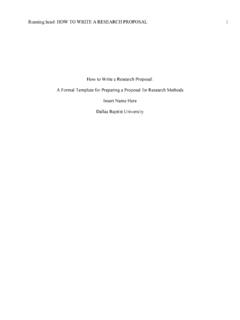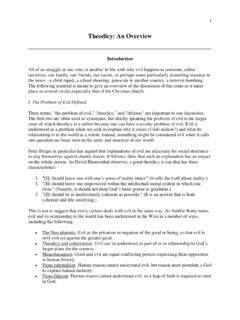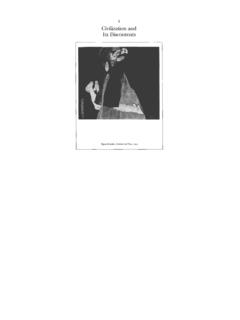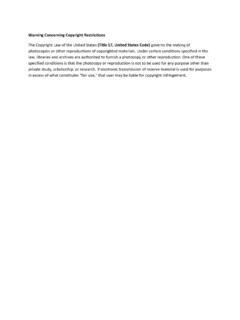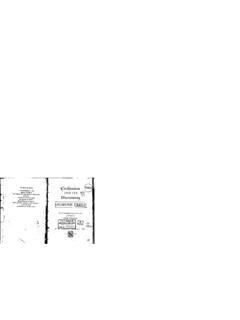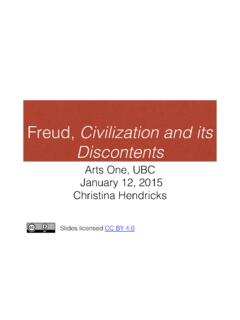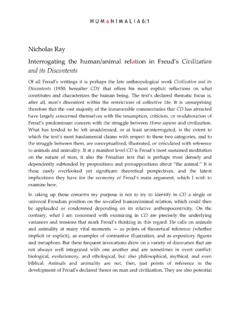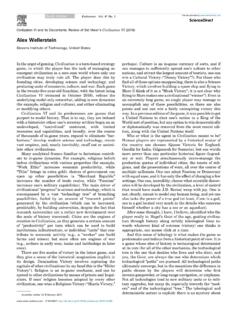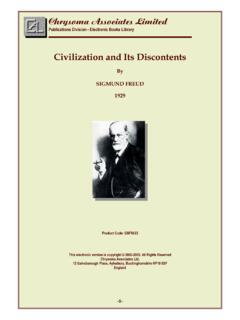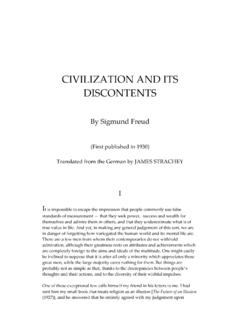Transcription of Civilization and Its Discontents (1930): Malaise and the ...
1 Civilization and Its Discontents (1930): Malaise and the Ur-Myth Such, then, was the original state of things: domination by whoever had the greater might domination by brute violence or by violence supported by intellect. As we know, this r gime was altered in the course of evolution. There was a path that led from violence to right or law. What was that path? It is my belief that there was only one: the path which led by way of the fact that the superior strength of a single individual could be rivalled by the union of several weak ones. L union fait la force. Violence could be broken by union, and the power of those who were united now represented law in contrast to the violence of the single individual. Thus we see that right is the might of a community.
2 It is still violence, ready to be directed against any individual who resists it; it works by the same methods and follows the same purposes. The only real difference lies in the fact that what prevails is no longer the violence of an individual but that of a community. But in order that the transition from violence to this new right or justice may be effected, one psychological condition must be fulfilled. The union of the majority must be a stable and lasting one. If it were only brought about for the purpose of combating a single dominant individual and were dissolved after his defeat, nothing would have been accomplished. The next person who thought himself superior in strength would once more seek to set up a dominion by violence and the game would be repeated ad infinitum.
3 The community must be maintained permanently, must be organized, must draw up regulations to anticipate the risk of rebellion and must institute authorities to see that those regulations the laws are respected and to superintend the execution of legal acts of violence. The recognition of a community of interests such as these leads to the growth of emotional ties between the members of a united group of people communal feelings which are the true source of its strength. Here, I believe, we already have all the essentials: violence overcome by the transference of power to a larger unity, which is held together by emotional ties between its members. What remains to be said is no more than an expansion and a repetition of this.
4 --Letter to Albert Einstein, 1932 (Why War?) Civilization and Its Discontents is classic late Freud--Freud the cultural icon makes numerous pseudo-scientific pronouncements based as much on mythos and just-so story as on his second topology of id-ego-superego. In many ways, the book is a mashup of Totem and Taboo with the second topography, but as the superb introduction by James Strachey in the Standard Edition shows, his basic suppositions about Kultur and neurosis go back to his late nineteenth-century musings. In many ways, Freud sets up strawman arguments in order to knock them down, but he himself becomes his own strawman in part because he backs up so little of his suppositions with anything but general assertions and strained analogies, which makes Civilization and Its Discontents a very readable book, if a very annoying one to the unconvinced.
5 Freud himself admitted as much to those close to him it is a book with little analysis and much bravado. Still, the book in many ways brings together much of Freud s long career of analysis and speculation. One of the more interesting (if again, highly problematic) aspects is Freud s mixed approach to the historical imagination. He defends his Ur-myth of the primal horde and the original parricide as a plausible piece of history (94), yet already thoroughly critiqued by anthropologists and historians, his explanatory story hardly holds up to counter-evidence. Freud s extended analogy from the archaeology of Rome is interesting in part because of Freud s own complex feelings about the city. He later admits that he is incapable of feeling the way past people might have felt in their cultural worlds (cf.)
6 41). In many ways Freud continues to build upon his favorite triad of Eros, the life force, and Thanatos, the death instinct, a battle of giants unsuccessfully kept apart by Ananke, the goddess of Necessity. For one who had not read Freud to this point, it might seem terribly strange to build up such a mythos even as one condemns religion as the false consolation of nursemaids. Yet by 1930, this sort of thing is rather par for the course, and one cannot help but think of Freud s own Catholic nanny, his Nana. Freud, raised in a nominal Reformed Jewish home, his mature exposure to the actual convictions and practices of the religious, especially Christians, was really very limited Oskar Pfister being one exception. Freud s picture of religion in Civilization and Its Discontents , like that in The Future of an Illusion, is not only reductive, but also rather na ve.
7 He knows nothing of the complex joys and comprehensive lifeworld of faith. Part of this is perhaps simply Freud s reductive pattern. Conscience is a psycho-social construction arising from remorse; guilt is only that of antagonistic feelings internalized; the Father God is a consolation and wish fulfillment that blinds one to the realities of human life and suffering; the figure of Christ is a scapegoat projection; even love is finally libidinal expressions of guilt and deferred desire. Perhaps part of it too arises from his own disappointments in his father and the history of Jewish suffering within Catholic Europe. His need to build a kind of counter-mythos is fascinating in its own way it has a rather Comtean impulse to it.
8 Yet part of his antagonism is simply old-hat skepticism it is not surprising that he alludes to Voltaire, Heinrich Heine, and Mark Twain in the work. Freud reduces wonder, gratitude, moral beauty, love of neighbor or of the stranger, to simple sexual and antagonistic impulses. He simply won t believe that the large good aspects are truly possible. For these reasons, I find Civilization and Its Discontents the saddest of Freud s books, a profane and bitter set of ironies. Discussion Questions 1. Why does Freud wish to explain the oceanic feeling of eternity as a projection from the ego s boundaries and sense of exteriority? (11-15) 2. Why does Freud offer his extended analogy with Roman archaeology only to reject it?
9 (17-20) 3. How does he argue for various auxiliary constructions being forms of the pleasure principle? (22-25) 4. How would you compare Freud s reasoning from pages 26-34 with the ideas of utilitarianism? Why does he think most people are neither capable of the higher consolations nor that they are worth much? 5. How does Freud invoke notions such as beauty and order and cleanliness only to reduce them to sublimation? (cf. Chapter III) 6. Why does Freud think that universal love is impossible? (57ff. 66-70) 7. Why does he think communism is not an answer? (71-73) 8. How does Freud reimagine the problem of evil? (79-82) 9. In Chapter VII, how does Freud argue that Civilization is based on anxiety, remorse, and aggression?
10 10. How does he contrast the external theory of internalized aggression with the internal economic theory of one s own aggression needing an outlet? (102-104) What does he see as the explanatory advantage to each? 11. Why is Freud suspicious of ethics? Does he reduce it to therapy and economic regulation of the desires? (108-110) 12. Reread the last paragraph (111-112). What does the ending of the book suggest about the historical context of Freud s thoughts?

